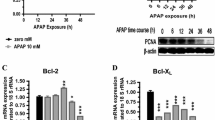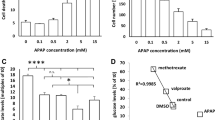Abstract
To study the biochemical and toxicological properties of cytochrome P450 2E1 (CYP2E1), an adenovirus containing human CYP2E1 cDNA (Ad-CYP2E1) was constructed and was shown to successfully mediate the overexpression of CYP2E1 in HepG2 cells. Acetaminophen (APAP) toxicity to HepG2 cells infected with Ad-CYP2E1 was characterized as a preliminary proof of principle experiment to validate the functionality of the CYP2E1 adenovirus. Compared with cells infected with Ad-LacZ, HepG2 cells infected with Ad-CYP2E1 were more sensitive to APAP induced necrosis and apoptosis when the cells were depleted of intracellular reduced glutathione (GSH). The APAP cytotoxicity was dependent on both the concentration of APAP and the multiplicity of infection of the Ad-CYP2E1 virus. Apoptosis induced by APAP in HepG2 cells overexpressing CYP2E1 was caspase dependent and could be inhibited by the pan-caspase inhibitor Z-VAD-fmk. After treatment with APAP, mitochondrial membrane potential was dramatically decreased in the CYP2E1-expressing cells. APAP protein adducts were elevated in HepG2 cells infected with Ad-CYP2E1 compared with that in cells infected with Ad-LacZ; two bands around 90 KD were found only in the CYP2E1-expressing cells. These results demonstrate that adenovirus-mediated overexpression of human CYP2E1 activates APAP to reactive metabolites which damage mitochondria, form protein adducts, and result in toxicity to HepG2 cells. The Ad-CYP2E1 may be useful for studies designed to investigate the role of CYP2E1 in APAP and alcoholic liver injury and to further characterize the actions and effects of CYP2E1. (Mol Cell Biochem 262: 165–176, 2004)
Similar content being viewed by others
References
Bessems JG, Vermeulen NP: Paracetamol (acetaminophen)-induced toxicity: Molecular and biochemical mechanisms, analogues and protective approaches. Crit Rev Toxicol 31: 55–138, 2001
Prescott LF: Paracetamol overdosage. Pharmacological considerations and clinical management. Drugs 25: 290–314, 1983
Black M: Acetaminophen hepatotoxicity. Annu Rev Med 35: 577–593, 1984
Raucy JL, Lasker JM, Lieber CS, Black M: Acetaminophen activation by human liver cytochromes P450IIE1 and P450IA2. Arch Biochem Biophys 271: 270–283, 1989
Dahlin DC, Nelson SD: Synthesis, decomposition kinetics, and preliminary toxicological studies of pure N-acetyl-p-benzoquinone imine, a proposed toxic metabolite of acetaminophen. J Med Chem 25: 885–886, 1982
MoldÂeus P: Paracetamol metabolism and toxicity in isolated hepatocytes from rat and mouse. Biochem Pharmacol 27: 2859–2863, 1978
Van De Straat R, De Vries J, Kulkens T, Debets AJ, Vermeulen NP: Paracetamol, 3-monoalkyl-and 3,5-dialkyl derivatives. Comparison of their microsomal cytochrome P-450 dependent oxidation and toxicity in freshly isolated hepatocytes. Biochem Pharmacol 35: 3693–3699, 1986
Hoffmann KJ, Streeter AJ, Axworthy DB, Baillie TA: Identification of the major covalent adduct formed in vitro and in vivo between acetaminophen and mouse liver proteins. Mol Pharmacol 27: 566–573, 1985
Hinson JA, Pumford NR, Roberts DW: Mechanisms of acetaminophen toxicity: Immunochemical detection of drug-protein adducts. Drug Metab Rev 27: 72–92, 1995
Birge RB, Bartolone JB, Nishanian EV, Bruno MK, Mangold JB, Cohen SD, Khairallah EA: Dissociation of covalent binding from the oxidative effects of acetaminophen. Studies using dimethylated acetaminophen derivatives. Biochem Pharmacol 37: 3383–3393, 1988
Tirmenstein MA, Nelson SD: Acetaminophen-induced oxidation of protein thiols. Contribution of impaired thiol-metabolizing enzymes and the breakdown of adenine nucleotides. J Biol Chem 265: 3059–3065, 1990
Hongslo JK, Smith CV, Brunborg G, S2derlund EJ, Holme JA: Genotoxicity of paracetamol in mice and rats. Mutagenesis. 9: 93–100, 1994
Thummel KE, Lee CA, Kunze KL, Nelson SD, Slattery JT: Oxidation of acetaminophen to N-acetyl-p-aminobenzoquinone imine by human CYP3A4. Biochem Pharmacol 45: 1563–1569, 1993
Prasad JS, Chen NQ, Liu YX, Goon DJ, Holtzman JL: Effects of ethanol and inhibitors on the binding and metabolism of acetaminophen and Nacetyl-p-benzoquinone imine by hepatic microsomes from control and ethanol-treated rats. Biochem Pharmacol 40: 1989–1995, 1990
Burk RF, Hill KE, Hunt RW, Jr., Martin AE: Isoniazid potentiation of acetaminophen hepatotoxicity in the rat and 4-methylpyrazole inhibition of it. Res Commun Chem Pathol Pharmacol 69: 115–118, 1990
Rex DK, Kumar S: Recognizing acetaminophen hepatotoxicity in chronic alcoholics. Postgrad Med 91: 241–245, 1992
Dai Y, Cederbaum AI: Cytotoxicity of acetaminophen in human cytochrome P4502E1-transfected HepG2 cells. J Pharmacol Exp Ther 273: 1497–1505, 1995
Holownia A, Mapoles J, Menez JF, Braszko JJ: Acetaminophen metabolism and cytotoxicity in PC12 cells transfected with cytochrome P4502E1. J Mol Med 75: 522–527, 1997
Lee SS, Buters JT, Pineau T, Fernandez-Salguero P, Gonzalez FJ: Role of CYP2E1 in the hepatotoxicity of acetaminophen. J Biol Chem 271: 12063–12067, 1996
Cederbaum AI, Wu D, Mari M, Bai J: CYP2E1-dependent toxicity and oxidative stress in HepG2 cells. Free Radical Biol Med 31: 1539–1543, 2001
Guengerich FP, Kim DH, Iwasaki M: Role of human cytochrome P-450 IIE1 in the oxidation of many low molecular weight cancer suspects. Chem Res Toxicol 4: 168–179, 1991
Yang CS, Yoo JS, Ishizaki H, Hong JY: Cytochrome P450IIE1: Roles in nitrosamine metabolism and mechanisms of regulation. Drug Meta Rev 22: 147–159, 1990
Koop DR: Oxidative and reductive metabolism by cytochrome P450 2E1. FASEB J 6: 724–730, 1992
Morimoto M, Zern MA, Hagbjéork AL, Ingelman-Sundberg M, French SW: Fish oil, alcohol, and liver pathology: Role of cytochrome P450 2E1. Proc Soc Exp Biol Med 207: 197–205, 1994
Nanji AA, Zhao S, Sadrzadeh SM, Dannenberg AJ, Tahan SR, Waxman DJ: Markedly enhanced cytochrome P450 2E1 induction and lipid peroxidation is associated with severe liver injury in fish oil-ethanol-fed rats. Alcohol Clin Exp Res 18: 1280–1285, 1994
Lieber CS: Cytochrome P-4502E1: Its physiological and pathological role. Physiol Rev 77: 517–544, 1997
Weltman MD, Farrell GC, Hall P, Ingelman-Sundberg M, Liddle C: Hepatic cytochrome P450 2E1 is increased in patients with nonalcoholic steatohepatitis. Hepatology 27: 128–133, 1998
Bett AJ, Haddara W, Prevec L, Graham FL: An efficient and flexible system for construction of adenovirus vectors with insertions or deletions in early regions 1 and 3. Proc Natl Acad Sci USA 91: 8802–8806, 1994
Bai J, Cederbaum AI: Catalase protects HepG2 cells from apoptosis induced by DNA-damaging agents by accelerating the degradation of p53. J Biol Chem 278: 4660–4667, 2003
Wiger R, Finstad HS, Hongslo JK, Haug K, Holme JA: Paracetamol inhibits cell cycling and induces apoptosis in HL-60 cells. Pharmacol Toxicol 81: 285–293, 1997
Ray SD, Mumaw VR, Raje RR, Fariss MW: Protection of acetaminophen-induced hepatocellular apoptosis and necrosis by cholesteryl hemisuccinate pretreatment. J Pharmacol Exp Ther 279: 1470–1483, 1996
Lindenthal J, Sinclair JF, Howell S, Cargill I, Sinclair PR, Taylor T: Toxicity of paracetamol in cultured chick hepatocytes treated with methotrexate. Eur J Pharmacol228: 289–298, 1993
Patten CJ, Thomas PE, Guy RL, Lee M, Gonzalez FJ, Guengerich FP, Yang CS: Cytochrome P450 enzymes involved in acetaminophen activation by rat and human liver microsomes and their kinetics. Chem Res Toxicol 6: 511–518, 1993
Gu J, Zhang QY, Genter MB, Lipinskas TW, Negishi M, Nebert DW, Ding X: Purification and characterization of heterologously expressed mouse CYP2A5 and CYP2G1: Role in metabolic activation of acetaminophen and 2,6-dichlorobenzonitrile in mouse olfactory mucosal microsomes. J Pharmacol Exp Ther 285: 1287–1295, 1998
Genter MB, Liang HC, Gu J, Ding X, Negishi M, McKinnon RA, Nebert DW: Role of CYP2A5 and 2G1 in acetaminophen metabolism and toxicity in the olfactory mucosa of the Cyp1a2(-/-) mouse. Biochem Pharmacol 55: 1819–1826, 1998
Kostrubsky VE, Szakacs JG, Jeffery EH, Wood SG, Bement WJ, Wrighton SA, Sinclair PR, Sinclair JF: Role of CYP3A in ethanolmediated increases in acetaminophen hepatotoxicity. Toxicol Appl Pharmacol 143: 315–323, 1997
Kostrubsky VE, Szakacs JG, Jeffery EH, Woods SG, Bement WJ, Wrighton SA, Sinclair PR, Sinclair JF: Protection of ethanol-mediated acetaminophen hepatotoxicity by triacetyloleandomycin, a specific inhibitor of CYP3A. Ann Clin Lab Sci 27: 57–62, 1997
Zhang J, Huang W, Chua SS, Wei P, Moore DD: Modulation of acetaminophen-induced hepatotoxicity by the xenobiotic receptor CAR. Science 298: 422–424, 2002
Pumford NR, Hinson JA, PotterDW, Rowland KL, Benson RW, Roberts DW: Immunochemical quantitation of 3-(cystein-S-yl)acetaminophen adducts in serum and liver proteins of acetaminophen-treated mice. J Pharmacol Exp Ther 248: 190–196, 1989
Roberts DW, Bucci TJ, Benson RW, Warbritton AR, McRae TA, Pumford NR, Hinson JA: Immunohistochemical localization and quantification of the 3-(cystein-S-yl)-acetaminophen protein adduct in acetaminophen hepatotoxicity. Am J Pathol 138: 359–371, 1991
Hart SG, Cartun RW, Wyand DS, Khairallah EA, Cohen SD: Immunohistochemical localization of acetaminophen in target tissues of the CD-1 mouse: Correspondence of covalent binding with toxicity. Fundam Appl Toxicol 24: 260–274, 1995
Coles B, Wilson I, Wardman P, Hinson JA, Nelson SD, Ketterer B: The spontaneous and enzymatic reaction of N-acetyl-p-benzoquinonimine with glutathione: A stopped-flow kinetic study. Arch Biochem Biophys 264: 253–260, 1988
Henderson CJ, Wolf CR, Kitteringham N, Powell H, Otto D, Park BK: Increased resistance to acetaminophen hepatotoxicity in mice lacking glutathione S-transferase Pi. Proc Natl Acad Sci 97: 12741–12745, 2000
Jones AL: Mechanism of action and value of N-acetylcysteine in the treatment of early and late acetaminophen poisoning: A critical review. J Toxicol Clin Toxicol 36: 277–285, 1998
Larrauri A, Fabra R, Gâomez-Lechâon MJ, Trullenque R, Castell JV: Toxicity of paracetamol in human hepatocytes. Comparison of the protective effects of sulfhydryl compounds acting as glutathione precursors. Mol Toxicol 1: 301–311, 1987
Wendel A, Feuerstein S: Drug-induced lipid peroxidation in mice-I. Modulation by monooxygenase activity, glutathione and selenium status. Biochem Pharmacol 30: 2513–2520, 1981
Younes M, Cornelius S, Siegers CP: Ferrous ion supported in vivo lipid peroxidation induced by paracetamol-Its relation to hepatotoxicity. Res Commun Chem Pathol Pharmacol 51: 89–99, 1986
Younes M, Siegers CP: The role of iron in the paracetamol-and CCl4-induced lipid peroxidation and hepatotoxicity. Chem Biol Interact 55: 327–334, 1985
Devalia JL, Ogilvie RC, McLean AE: Dissociation of cell death from covalent binding of paracetamol by flavones in a hepatocyte system. Biochem Pharmacol 31: 3745–3749, 1982
Tee LG, Boobis AR, Davies DS: N-acetylcysteine for paracetamol overdose. Lancet 1: 331–332, 1986
Bajt ML, Knight TR, Farhood A, Jaeschke H: Scavenging peroxynitrite with glutathione promotes regeneration and enhances survival during acetaminophen-induced liver injury in mice. J Pharmacol Exp Ther 307: 67–73, 2003
Jaeschke H, Knight TR, Bajt ML: The role of oxidant stress and reactive nitrogen species in acetaminophen hepatotoxicity. Toxicol Lett 144: 279–288, 2003
Bae MA, Pie JE, Song BJ: Acetaminophen induces apoptosis of C6 glioma cells by activating the cJun NH(2)-terminal protein kinaserelated cell death pathway. Mol Pharmacol 60: 847–856, 2001
Boulares AH, Zoltoski AJ, Stoica BA, Cuvillier O, Smulson ME: Acetaminophen induces a caspase-dependent and Bcl-XL sensitive apoptosis in human hepatoma cells and lymphocytes. Pharmacol Toxicol 90: 38–50, 2002
Lawson JA, Fisher MA, Simmons CA, Farhood A, Jaeschke H: Inhibition of Fas receptor (CD95)-induced hepatic caspase activation and apoptosis by acetaminophen in mice.Toxicol Appl Pharmacol 156: 179–186, 1999
Knight TR, Jaeschke H: Acetaminophen-induced inhibition of Fas receptor-mediated liver cell apoptosis: mitochondrial dysfunction versus glutathione depletion. Toxicol Appl Pharmacol 181: 133–141, 2002
Shen W, Kamendulis LM, Ray SD, Corcoran GB: Acetaminopheninduced cytotoxicity in cultured mouse hepatocytes: Correlation of nuclear Ca2+ accumulation and early DNA fragmentation with cell death. Toxicol Appl Pharmacol 111: 242–254, 1991
Ray SD, Kamendulis LM, GuruleMW, Yorkin RD, Corcoran GB: Ca2+ antagonists inhibit DNA fragmentation and toxic cell death induced by acetaminophen. FASEB J 7: 453–463, 1993
Salas VM, Corcoran GB: Calcium-dependent DNA damage and adenosine 3',5'-cyclic monophosphate-independent glycogen phosphorylase activation in an in vitro model of acetaminophen-induced liver injury. Hepatology 25: 1432–1438, 1997
Lemasters JJ, Qian T, Elmore SP, Trost LC, Nishimura Y, Herman B, Bradham CA: Confocal microscopy of the mitochondrial permeability transition in necrotic cell killing, apoptosis and autophagy. BioFactors 8: 283–285, 1998
Gores GJ, Miyoshi H, Botla R, Aguilar HI, Bronk SF: Induction of the mitochondrial permeability transition as a mechanism of liver injury during cholestasis: A potential role for mitochondrial proteases. Biochim Biophys Acta 1366: 167–175, 1998
Burcham PC, Harman AW: Acetaminophen toxicity results in sitespecific mitochondrial damage in isolated mouse hepatocytes. J Biol Chem 266: 5049–5054, 1991
Author information
Authors and Affiliations
Rights and permissions
About this article
Cite this article
Bai, J., Cederbaum, A.I. Adenovirus mediated overexpression of CYP2E1 increases sensitivity of HepG2 cells to acetaminophen induced cytotoxicity. Mol Cell Biochem 262, 165–176 (2004). https://doi.org/10.1023/B:MCBI.0000038232.61760.9e
Issue Date:
DOI: https://doi.org/10.1023/B:MCBI.0000038232.61760.9e




